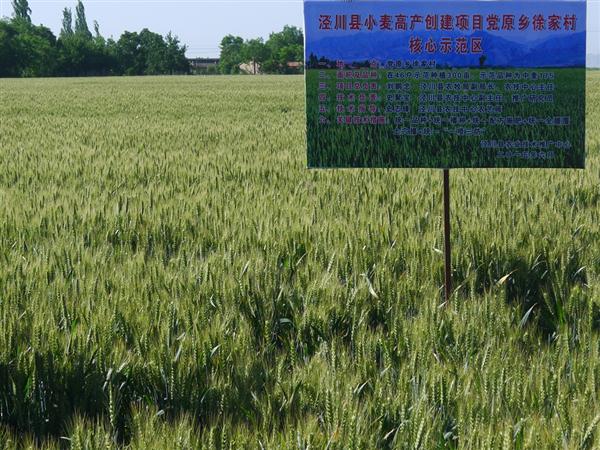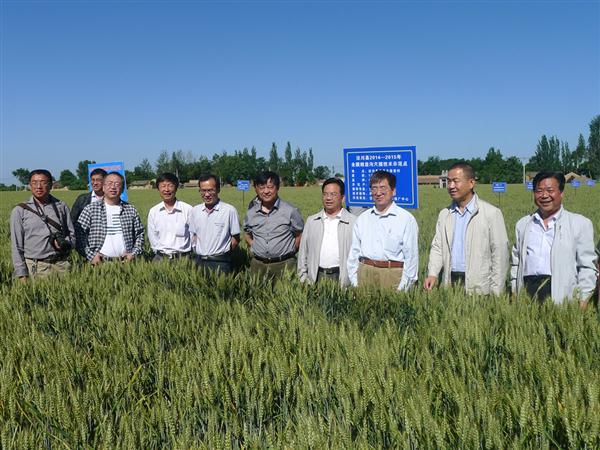Wheat Cultivar Zhongmai 175 Performed High Yielding in Eastern Gansu
Date:2015-09-07Author:AdminSource:ICS
Eastern Gansu province, usually called “Longdong”, is one of the typical drought areas during wheat growing season with an average yield about 3,750 kilograms per hectare (kg/ha). In these regions, the yield is not only low but also changes year by year. In the past, there was a lodging issue for local drought adapted cultivars when more rain received and the taller plants, but “Zhongmai 175” has totally changed the history, the cultivar has significantly increased the average yield in lands with good conditions from 6,000 kg/ha to 7,500 kg/ha in large scale. In Longdong, the highest yield record of winter wheat in drought condition was made using Zhongmai 175 in Xujia village, Dangyuan, Jingchuan, Pingliang when two large plots were randomly selected from “demonstration plot of Zhongmai 175 over 10,000 Mu” . The average yield was up to 8,040 kg/ha. The highest yielding performance of Zhongmai 175 has broken the long-time yield bar of 7,500 ka/ha in large area for the first time in history. “We used to think that wheat cultivars with taller plants and loose canopy type are more adapted to drought conditions and can use water in a wiser way, but Zhongmai 175 performed extremely well in these areas even it is a semi-dwarf cultivar with shorter plant statue and compact canopy structure. It is usually about 20 cm shorter than the local cultivars and has more than 30% of spikes in unit area. The lodging tolerance ensured yield stability even rain comes frequently under the global climate changing scenario, which will largely change our breeding objectives”, says Jiuyuan Du, a research professor at Institute of Wheat Research, Gansu Academy of Agricultural Sciences. With its wild adaptation feature, Zhongmai 175 can be planted in Shaanxi province as well, and reached the highest record of wheat yield in drought environment twice, and currently becomes the major cultivars in Huang-huai river wheat growing regions. It is the top one mega cultivar in the irrigation area of Beijing, Tianjin and northern Hebei in the past 5 years. Now it is also used widely in Gansu and Qinghai provinces to replace spring wheat which used to be dominant. In 2015, the total harvesting area has increased to 335,000 hectares.

Zhongmai 175 was developed and released by National Wheat Improvement Center, Institute of Crop and Sciences, Chinese Academy of Agricultural Sciences. Its high yielding performance has combined well with its good quality feature and water/fertilizer use efficiency, winter tolerance, disease resistance, lodging resistance, and heat tolerance and early heading/maturity as well, which made the cultivar adapted well in both irrigation and rainfed environments. There are four excellent performance for the cultivar: 1) Semi-dwarf, lodging resistance and high yielding. One highest yield record of 9169.5 kg/ha in Northern Winter Wheat Regions was created using Zhongmai 175 planting in Liulihe, Fangshan, Beijing in 2008. The cultivar was selected as a major cultivar in high-yielding demo-plot in Tianjin, Hebei, Gansu and Shaanxi provinces and recommended as a leading cultivar by Ministry of Agriculture in 2015. 2) Water and fertilizer use efficiency. In 2013 and 2014, about 100 released cultivars of winter and/or facultative wheat were tested for WUE in the same location in Shijiazhuang Academy of Agricultural Sciences, Shijiazhuang, Heibei province, Zhongmai 175 topped the No. 1 with an average yield of 9205.5 kg/ha when limited water (one-irrigation) was applied. Fertilizer use efficiency such as N/P was also tested on a collection of about 60 cultivars in Institute of Genetics and Developmental Biology, Chinese Academy of Sciences, Beijing, Zhongmai 175 performed also very well and was the best bet for N/PUE when limited fertilizer was applied. Sources from farmers in Longdong and Shaanxi indicated that Zhongmai 175 is a very popular cultivar in market and was highly recommended by famers when they have lands in drought environments and even in extreme drought conditions. 3) Good resistance and wild adaptation. It has cold tolerance in winter and frost resistance in April the time frost comes frequently in major winter wheat growing areas, is highly resistant to stripe rust, leaf rust and powdery mildew, fast filling rate, stay green feature, early or medium maturity and tolerance to the terminal heat. 4) Good quality for noodle product and high micronutrients such as zinc and iron. The noodle quality has good taste and color, high elastic and is outperform the best check “Snow flour”. Grain zinc concentration is about 30% higher than other common leading cultivars. The biofortified feature is good for human health especially for children and pregnant women.

